Are you a thick-crust pizza lover? Then, you must try my simple Sicilian-style pizza recipe.
It has a delicious, almost focaccia-like thick pizza crust topped with an easy tomato pizza sauce and heavenly flavored with sweet onions, herbs, and olive oil.
I'll show you step-by-step how to make it in your home oven for the perfect pizza night.
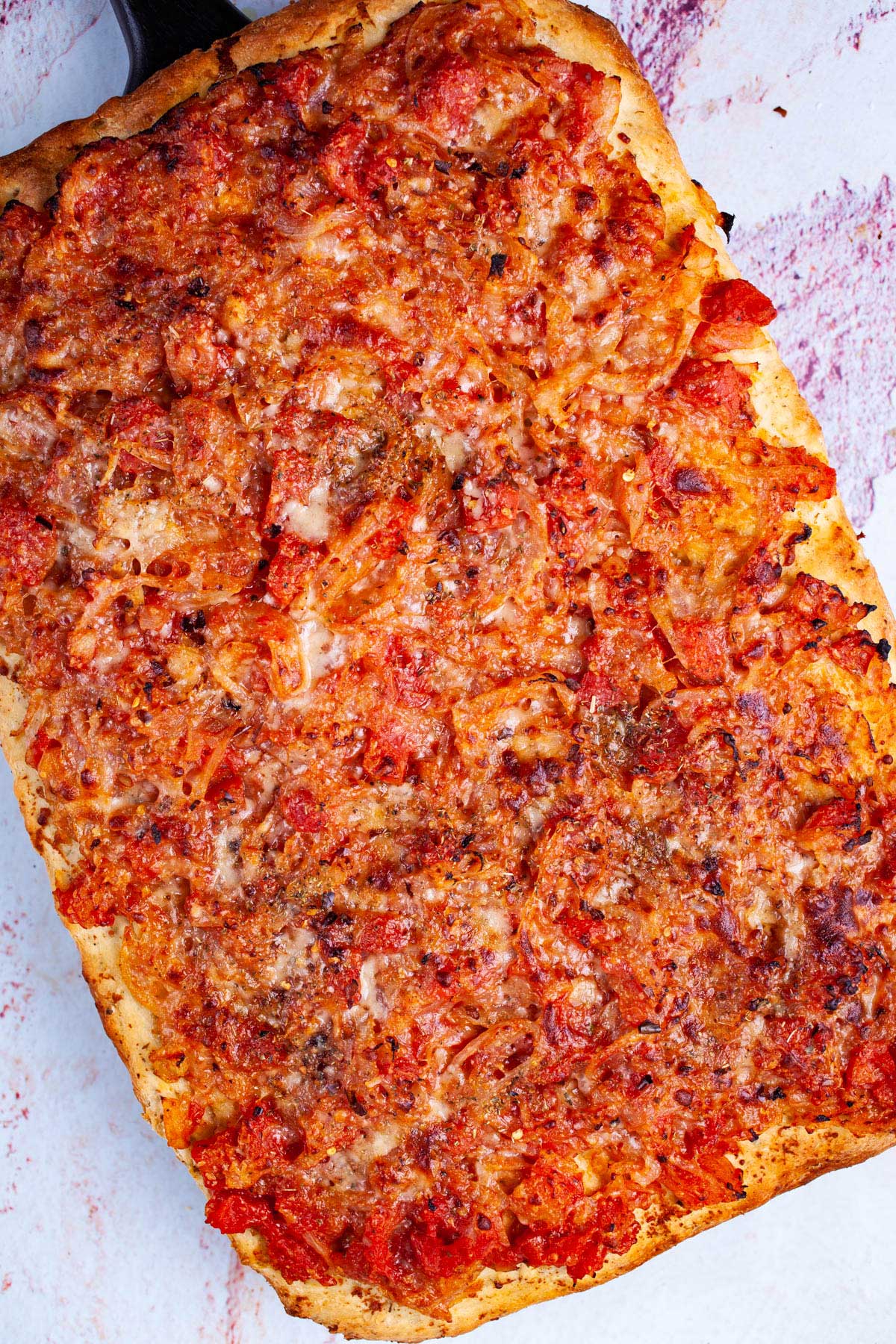
My grandmother would make this Sicilian pizza once or twice a year. It was a specialty food when I grew up!
I want to share it on the blog because it is part of my childhood and the perfect pizza to enjoy with family and friends.
Homemade comfort foods can easily fit into a healthy lifestyle as long as they are enjoyed in moderation—and this Sicilian pizza is pure homemade goodness.
Let's make it.
If you want a gluten-free pizza recipe, try my cornmeal pizza crust.
Jump to:
Reasons to Make This Pizza Recipe
- This original pizza recipe is made by hand without a rolling pin.
- It's an easy, authentic thick-crust pizza with fresh ingredients.
- It can feed a large family or crowd.
- If you want, make this Sicilian pizza ahead of time and freeze it.
- Leftovers store easily in the fridge.
- No special equipment is needed, only a large sheet pan.
- You can also use the pizza dough and add your favorite toppings.
Ingredients & Notes to Make The Dough
See the recipe card for full information on ingredients and quantities.
For a perfect homemade Sicilian pizza dough, you only need a few basic ingredients: flour, yeast, sugar, water, olive oil, and a few seasoning.
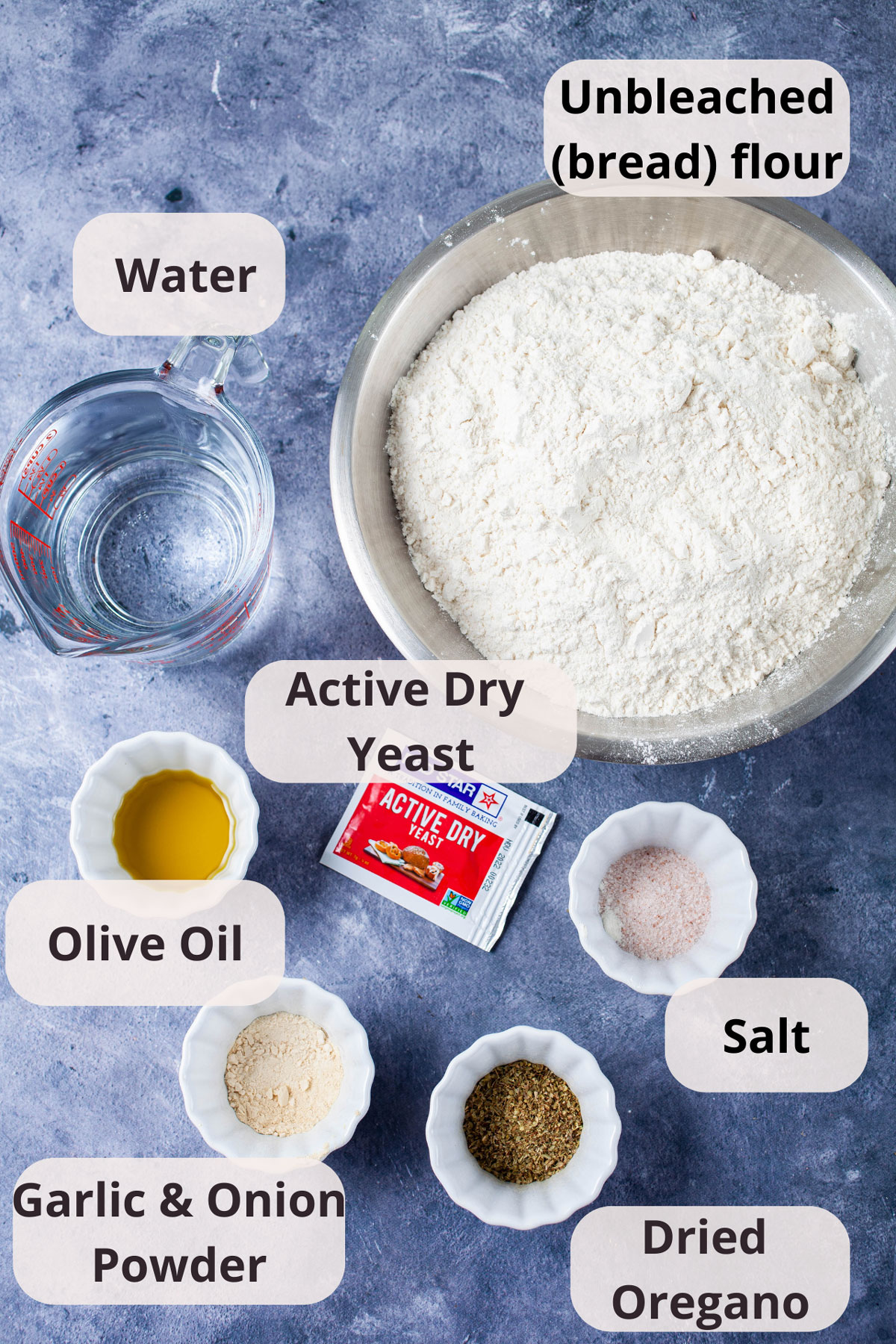
Flour: You can use bread or all-purpose flour.
Water: You'll need about 2 ¼ cups, but always have more on hand as required. It helps activate the yeast and hydrate the flour.
Active dry yeast: It will make the dough rise and give the crust an airy texture.
Note: This ingredient deviates from the original recipe, which calls for fresh yeast. However, fresh yeast has a short two-week shelf life, costs more, must be refrigerated, and not all markets carry it. So, I always use active dry yeast, which works just as well, and extras can be used to make my dried fig cake recipe or zeppole doughnuts.
Olive oil: I'm adding one tablespoon for a smooth elastic finish, and it adds wonderful flavor to the pizza dough.
Seasoning: Salt, garlic powder, onion powder, and oregano adds delicious authentic Italian flavors to the homemade pizza crust. Salt also helps to strengthen the gluten in the dough.
Sugar: I'm only using a bit to help activate the yeast.
Ingredients & Notes to Make The Pizza Sauce
See the recipe card for full information on ingredients and quantities.
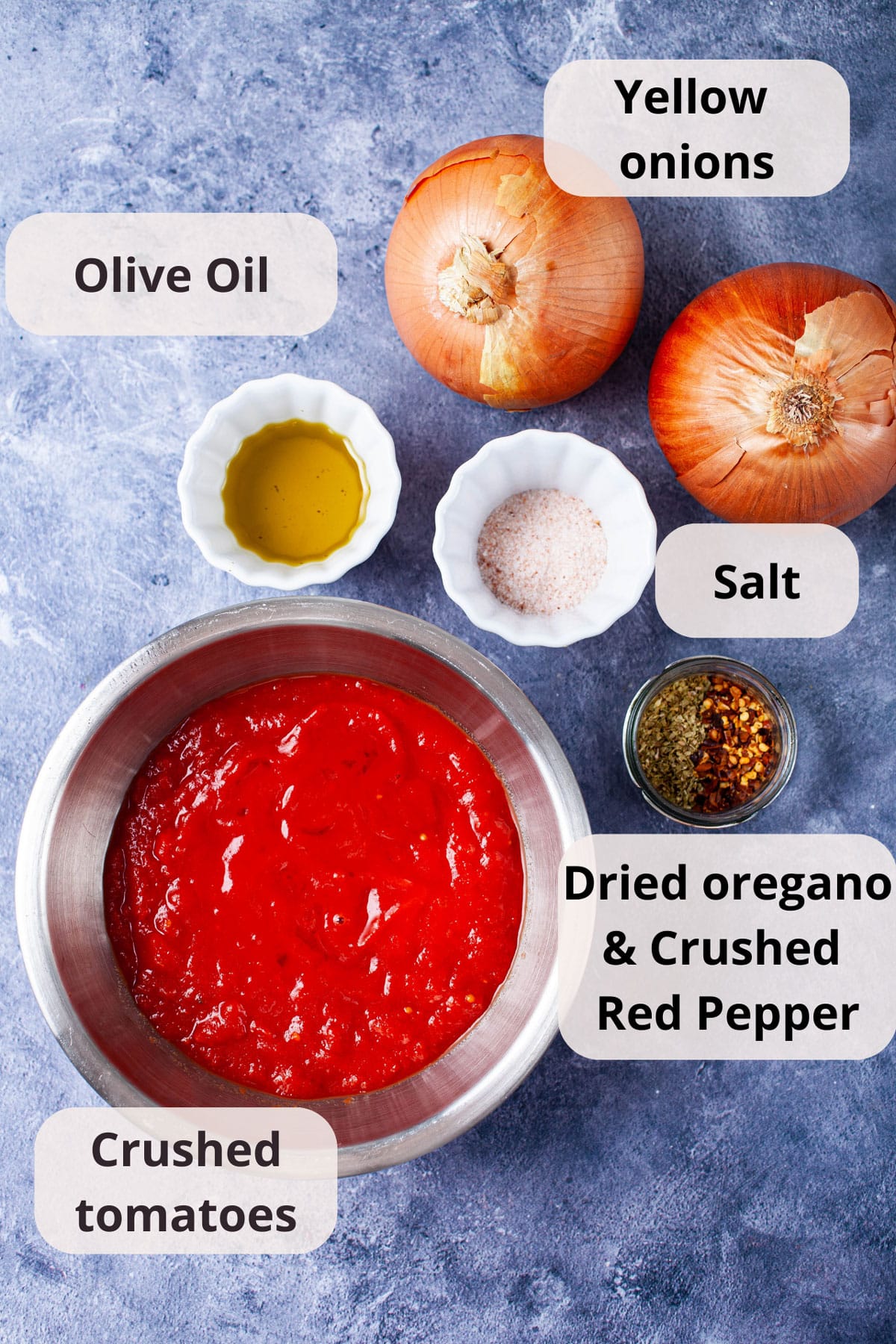
Crushed tomatoes: Use good-quality crushed tomatoes for a rich and flavorful sauce. Best to pick pure sweet tomatoes straight out of the jar or can with no additions (I love the Jovial brand.) You can also use leftovers of my red pasta sauce instead.
Onions: Best onions for pizza are yellow onions. They become deliciously sweet once browned and won't overpower the rest of the seasoning.
Olive oil: Always use good quality olive oil! It adds tons of flavor.
Seasoning: Salt, dried oregano, and crushed red peppers add Italian aromatic flavors and a hint of spiciness.
Note: Traditionally, it is a meatless pizza sauce made from tomatoes, lots of onions, and herbs sans the anchovies. If you are going for the New York Style Sicilian pizza, sprinkle on top fresh mozzarella cheese (if you don't mind some dairy) or add Grated Parmesan or Pecorino cheese for a cheesy bite.
How to Rehydrate Active Dry Yeast
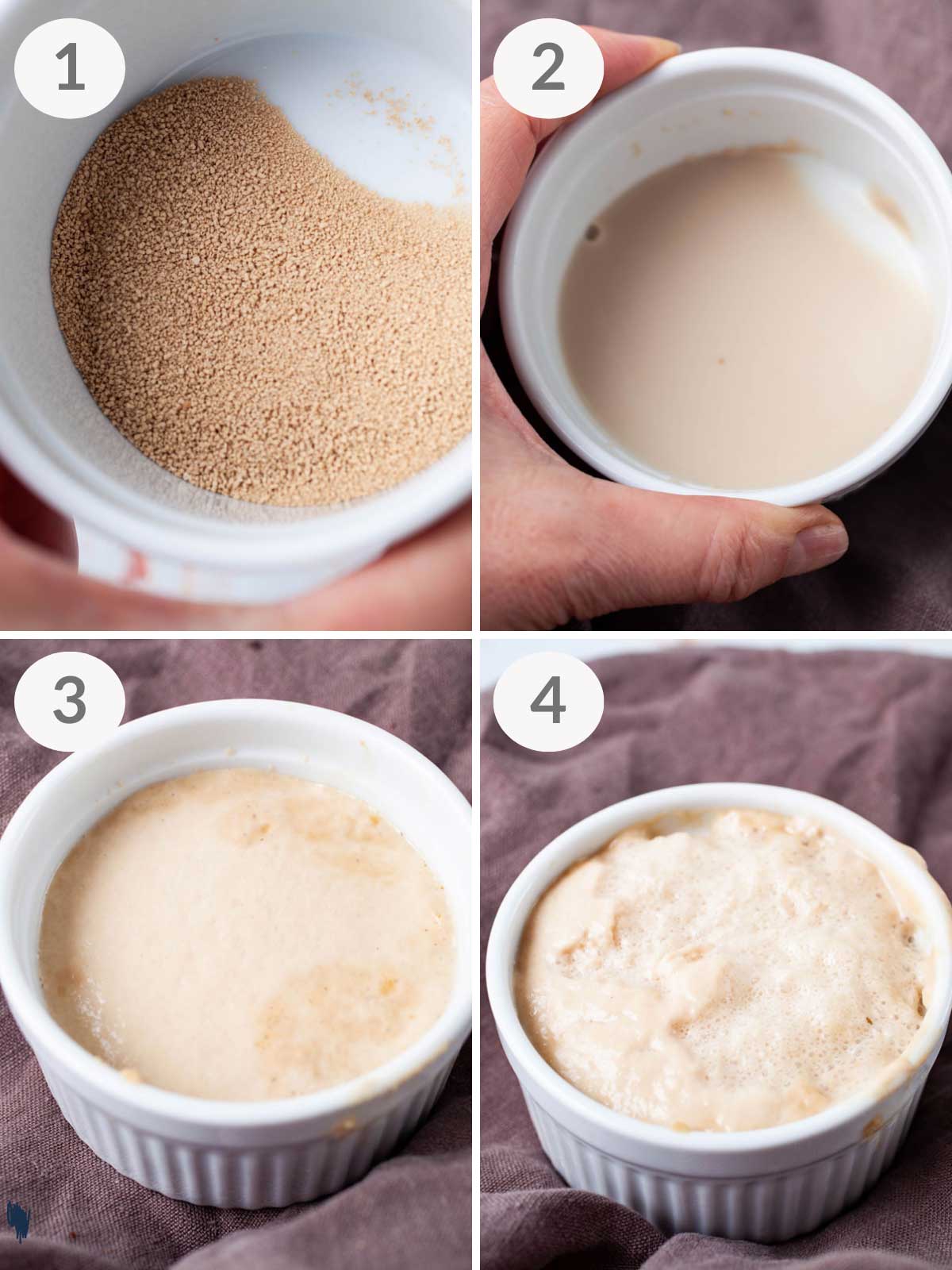
Step One (Picture 1 above) - Place active dry yeast in a small bowl.
Step Two (Picture 2 above) - Add some sugar and stir in lukewarm water.
Step Three (Picture 3 above) - Let it rest for 5 to 10 minutes. Best to cover it with a clean kitchen towel to keep it warm.
Step Four (Picture 4 above) - The yeast will bloom and almost double in size.
Note: Always check the expiration date of your active dry yeast packets—they expire fast. I also usually buy a pack of three, so if one does not bloom, I always have an extra one.
How to Make Sicilian Pizza
See the full recipe with measurements in the recipe card.
We start with making the Sicilian pizza dough by hand and then proceed with making the whole pizza. It's all easy and fun to make—and you don't need a stand mixer.
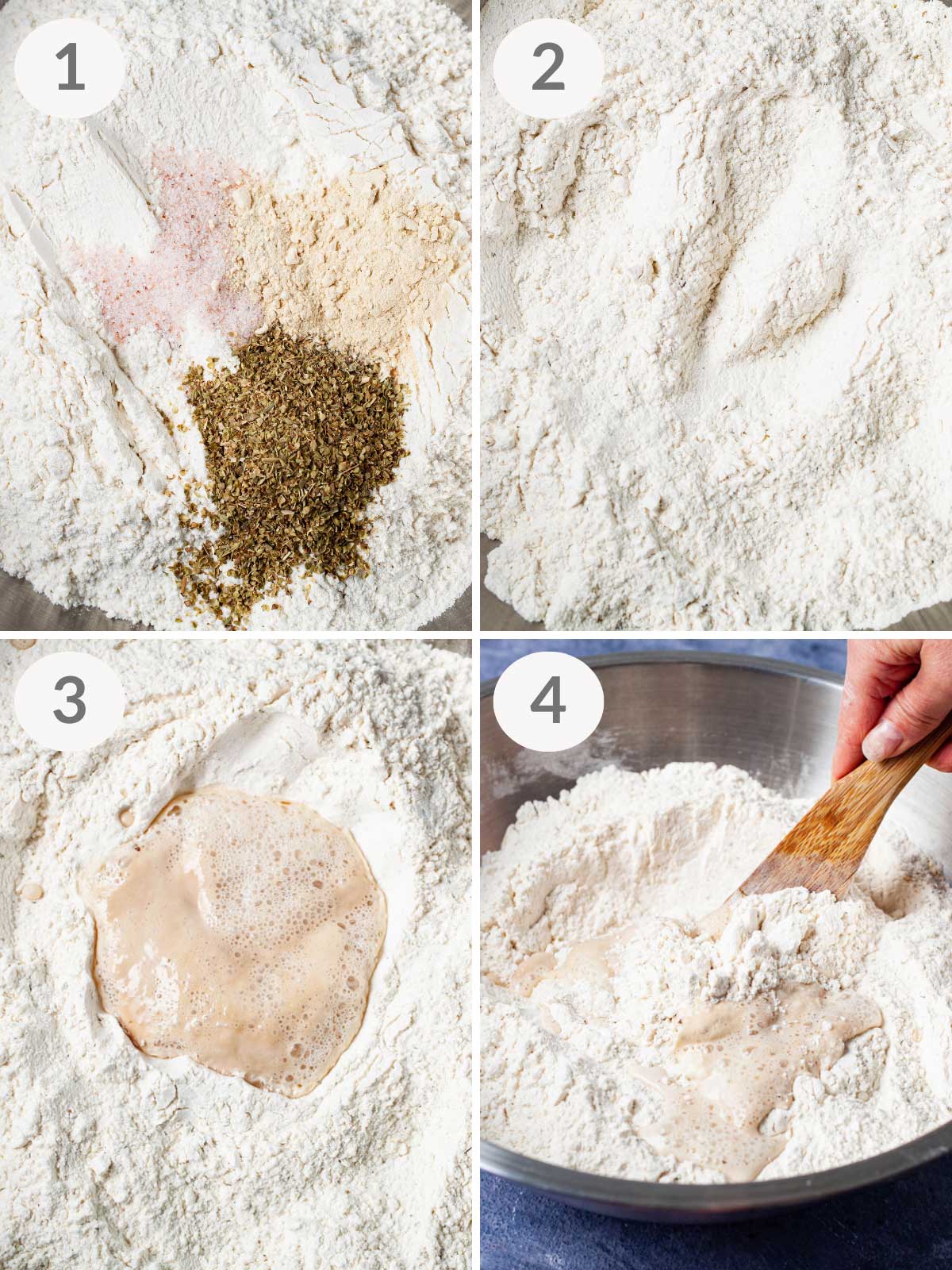
Step One (Picture 1 above) - In a large mixing bowl, add flour, salt, oregano, and the rest of the spices.
Step Two (Picture 2 above) - Use a whisk to combine the dry ingredients and fluff up the flour.
Step Three (Picture 3 above) - Add the bloomed yeast.
Step Four (Picture 4 above) - Gently stir to combine.
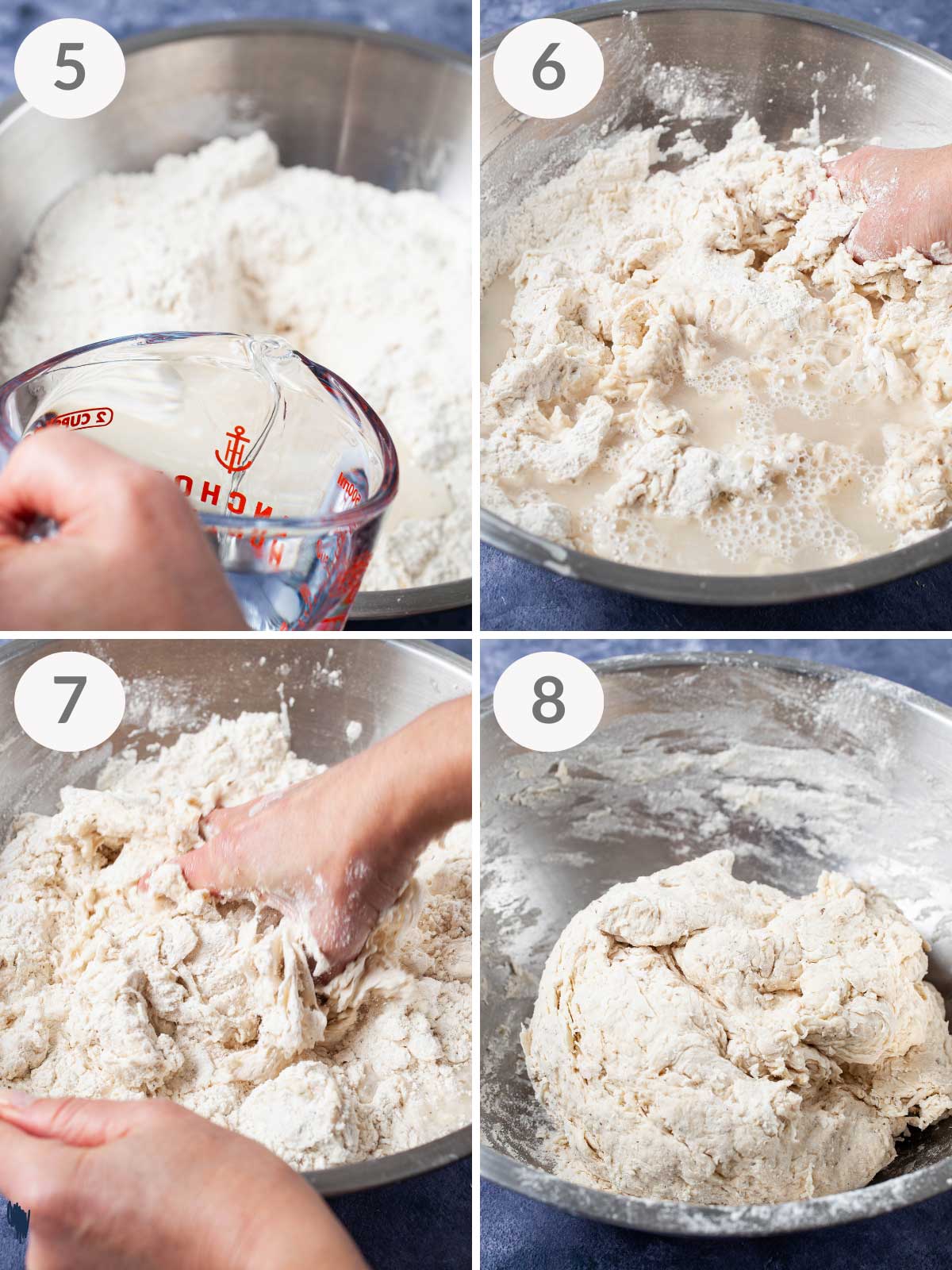
Step Five (Picture 5 above) - Gradually add water to the flour mixture.
Step Six (Picture 6 above) - Combine by hand.
Step Seven (Picture 7 above) - Keep combining the water with the flour until the flour starts holding together—it goes quickly.
Step Eight (Picture 8 above) - The flour will absorb all the water, and as you keep kneading, you will form a rough ball of dough. Then work in one tablespoon of olive oil.
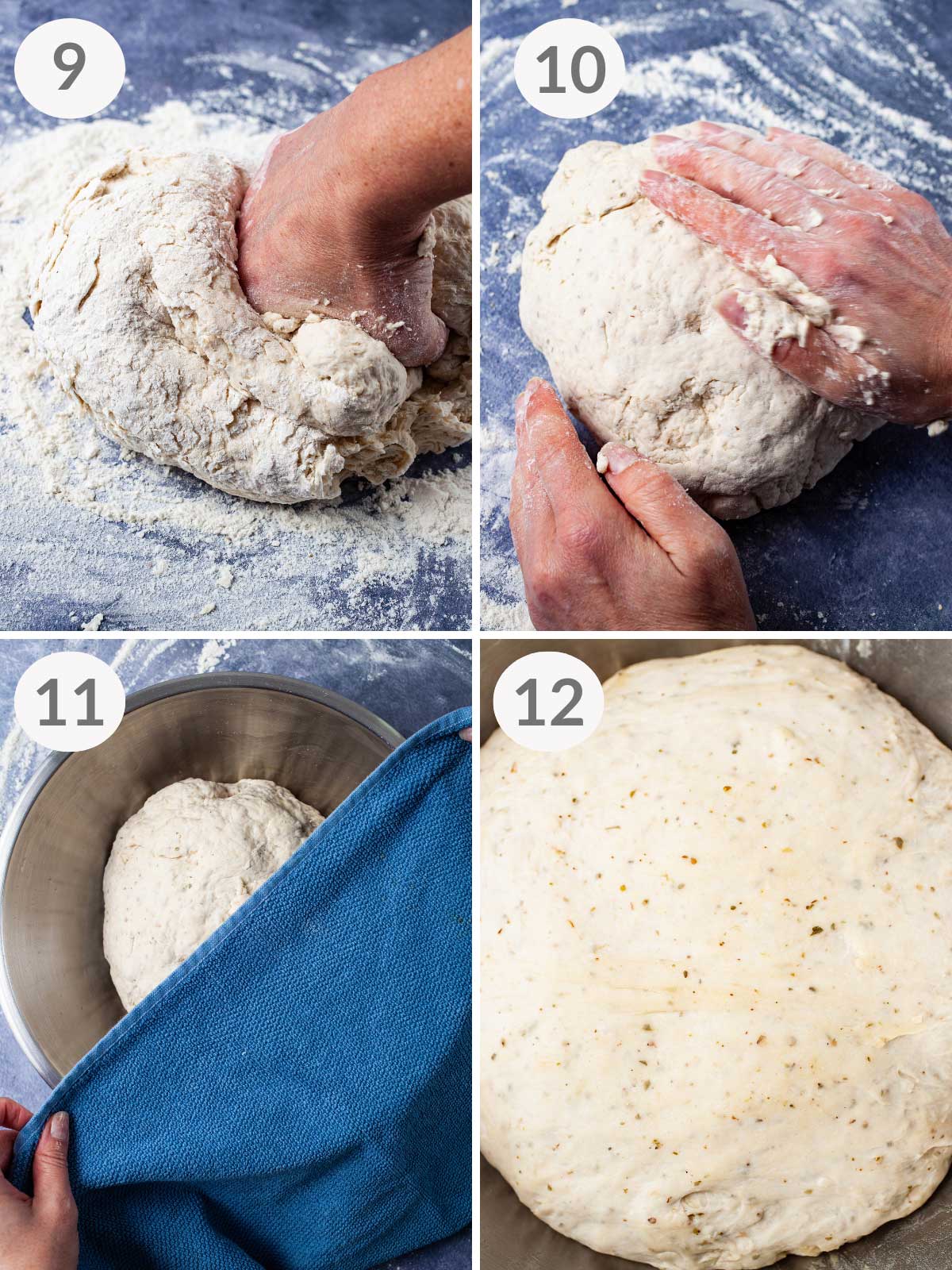
Step Nine (Picture 9 above) - Remove the dough from the large bowl and place it on a lightly floured surface.
Step Ten (Picture 10 above) - Knead the dough for a few minutes until it becomes smooth and elastic.
Step Eleven (Picture 11 above) - Place the dough in a lightly oiled large bowl and cover it with a clean kitchen towel.
Step Twelve (Picture 12 above) - Let it rise for 90 minutes at room temperature and until the dough has almost doubled in size (first rise).
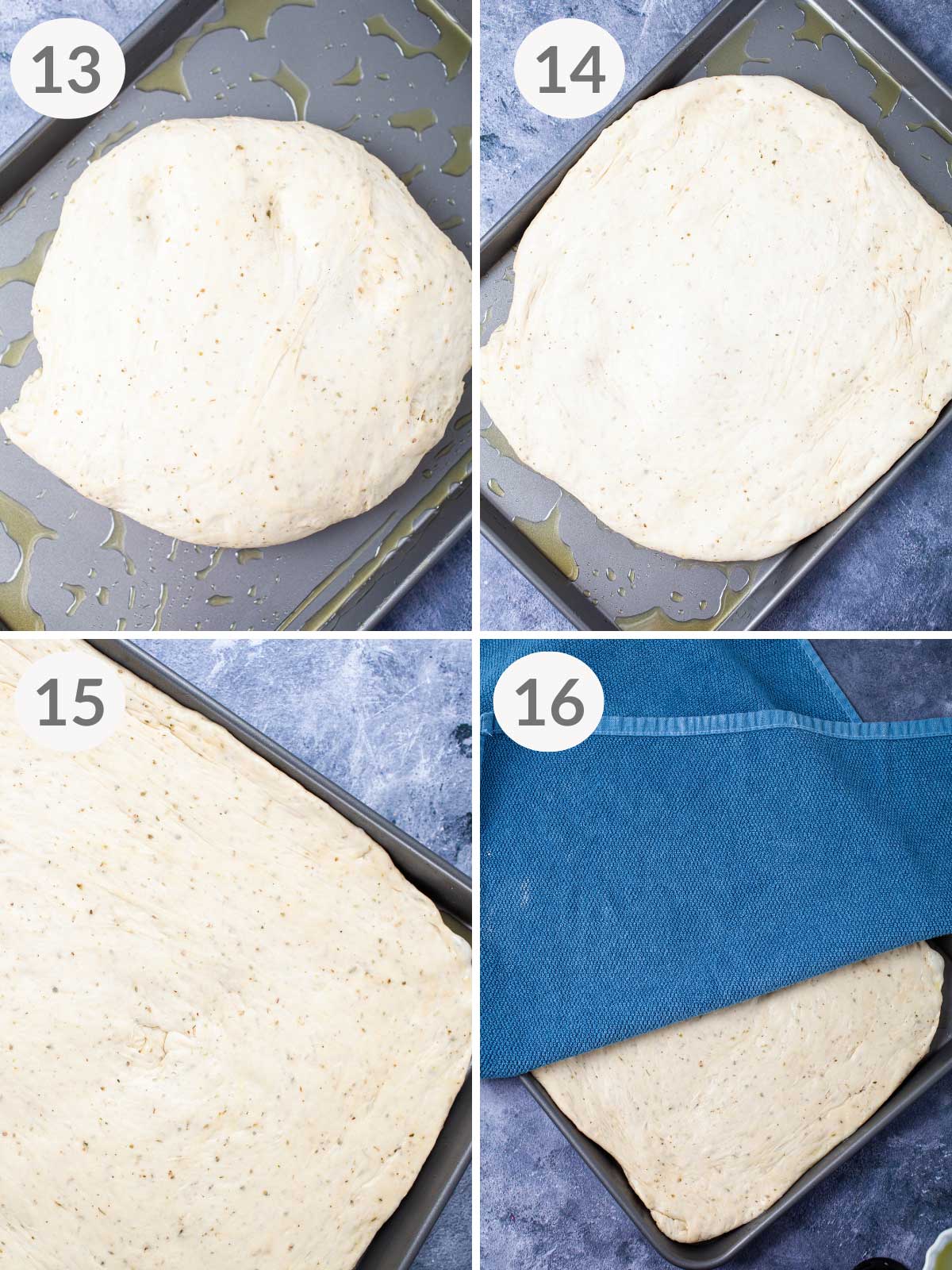
Step Thirteen (Picture 13 above) - Lightly oil the sheet pan and place the risen dough in the center of the sheet.
Step Fourteen (Picture 14 above) - Gently stretch and push the dough out—coercing the crust to the pan's edges.
Step Fifteen (Picture 15 above) - Keep doing that until the elastic dough covers almost the whole length of the baking sheet and the dough stops resisting.
Step Sixteen (Picture 16 above) - Cover it again with a clean kitchen towel and let it rest at room temperature for another 30 minutes.
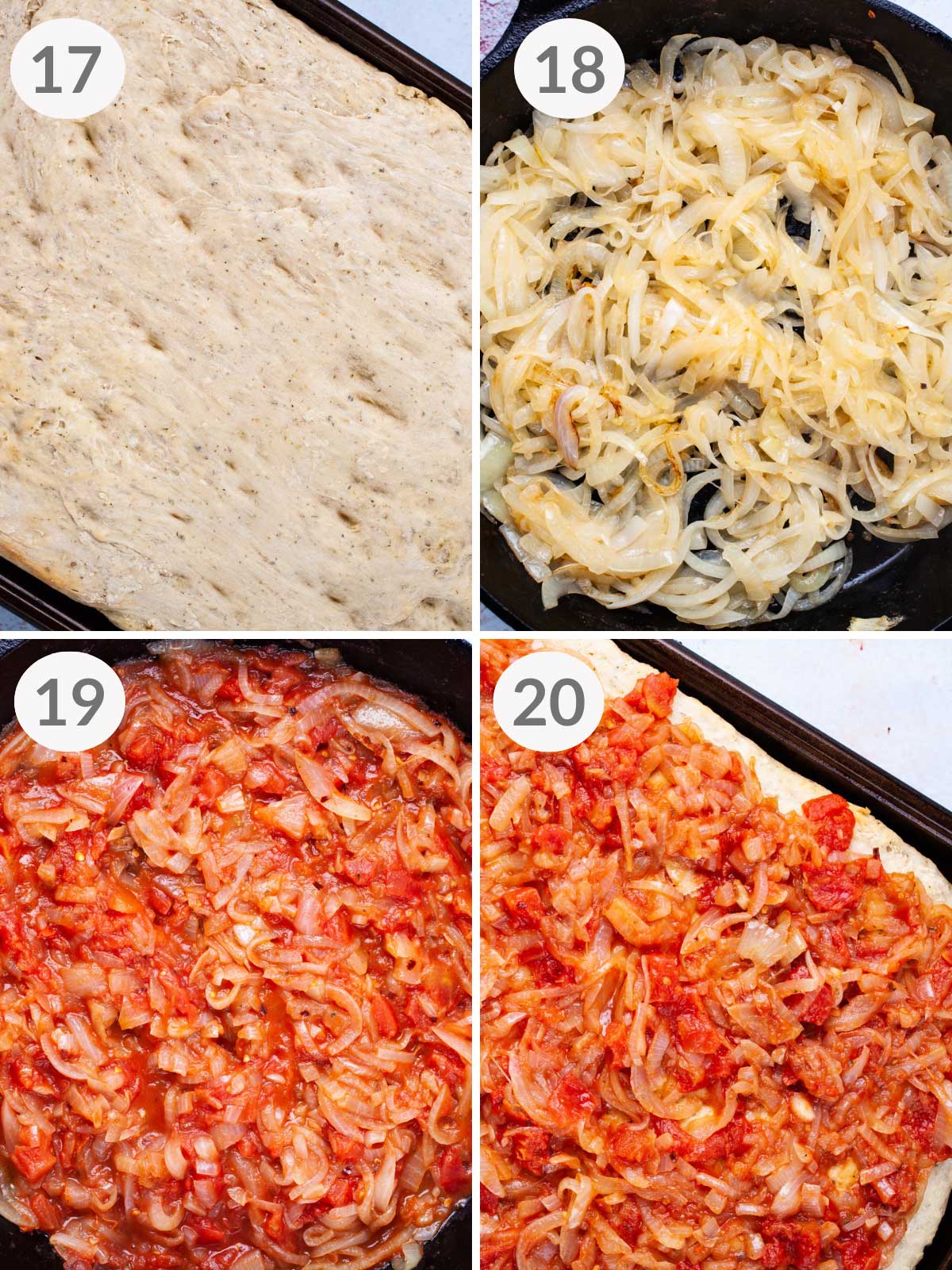
Step Seventeen (Picture 17 above) - Pre-bake the dough for 12 minutes in the oven until firm at the top and the edges are slightly brown.
Step Eighteen (Picture 18 above) - In the meantime, brown the onions in a little olive oil over medium-high heat.
Step Nineteen (Picture 19 above) - Stir in the crushed tomatoes for a few minutes—you can also use the same amount of my go-to homemade tomato sauce sans meatballs. Season with salt, oregano, and red pepper flakes.
Step Twenty (Picture 20 above) - Evenly distribute the pizza sauce on top of the pre-baked crust. I suggest brushing the edges of the dough with a bit of extra olive oil.
Note: alternatively, you can brush the whole crust with a little olive oil before adding the toppings for extra flavor.
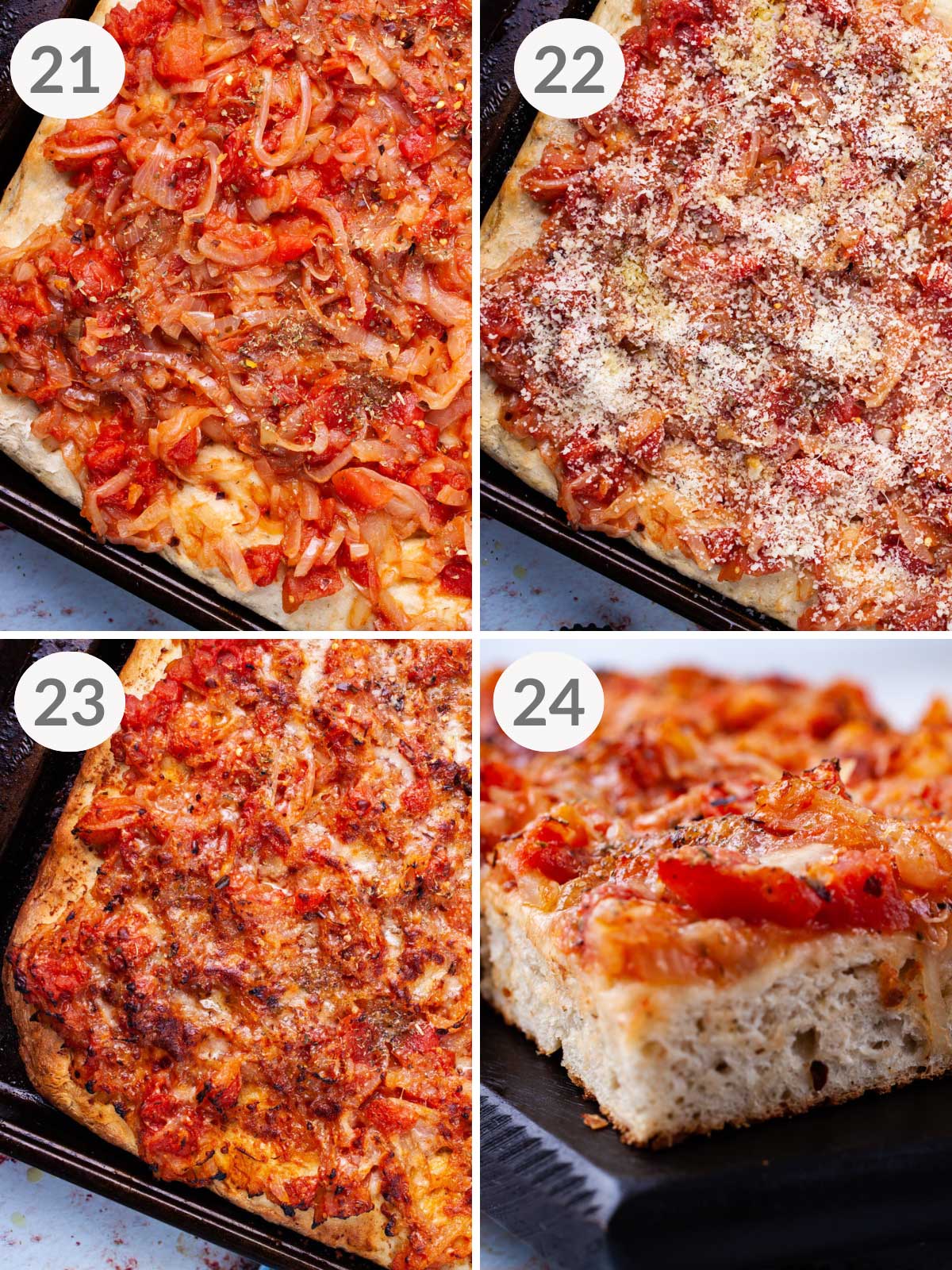
Step Twenty-One (Picture 21 above) - Season with the remaining dried oregano and red pepper flakes. Add more red pepper if you like it extra spicy.
Step Twenty-Two (Picture 22 above) - Sprinkle fine-grated Parmesan cheese on top (optional).
Step Twenty-Three (Picture 23 above) - Bake for another 15 minutes until the crust is firm at the bottom with crispy edges.
Step Twenty-Four (Picture 24 above) - Cut into squared or rectangular shapes and enjoy!
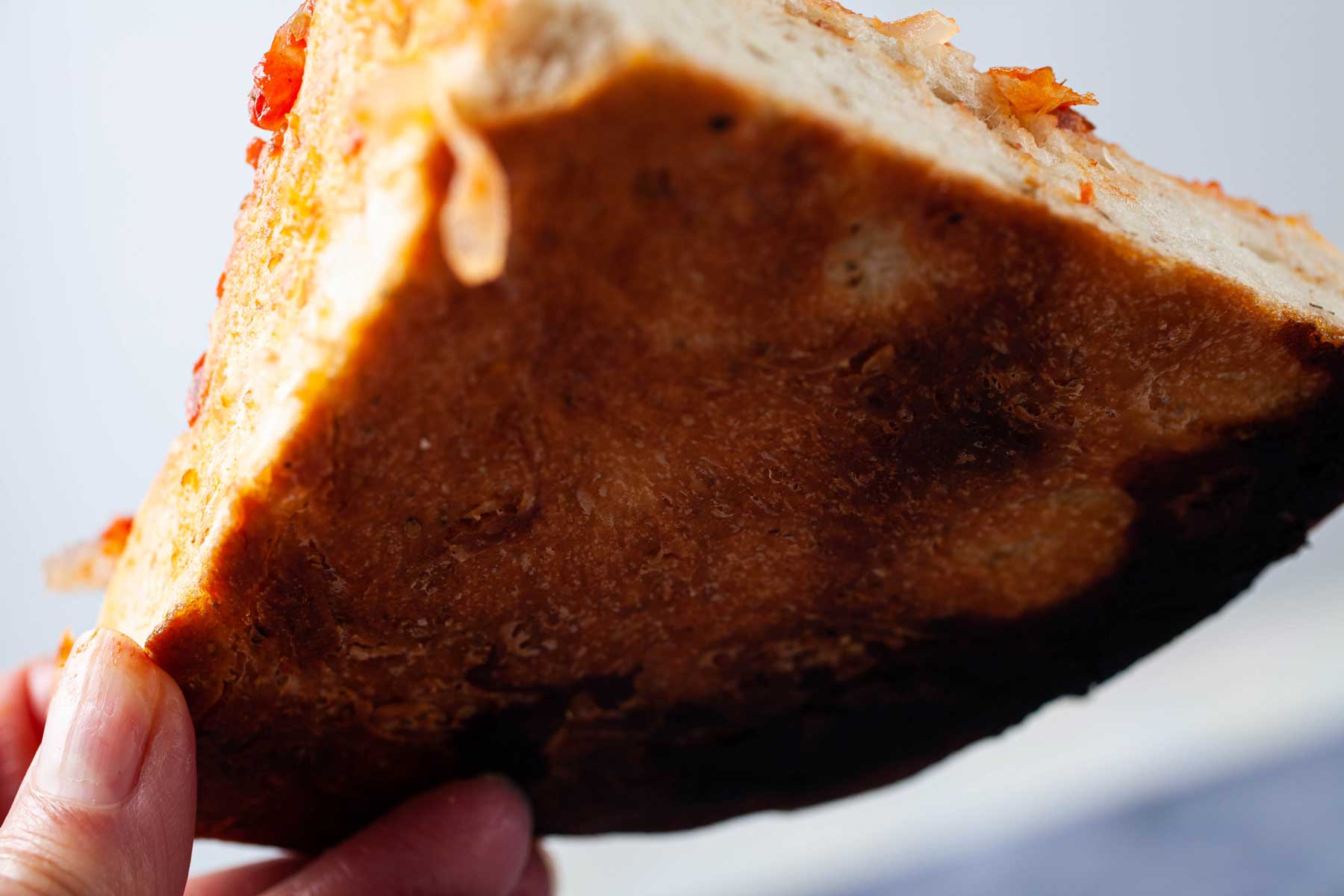
Look at that beautifully browned and crispy crust.
Expert Tips
- Let the dough rise properly: For a thick and airy crust, it's important to let your dough rise properly at room temperature to develop the gluten strands that give the crust its structure.
- If you have the time, a 90 minutes second rise instead of 30 will give you an even lighter crust.
- Bake this thick-crust pizza close to the oven floor, where it will get the most radiant heat from the base. It will help crisp up the bottom of the pizza and create a beautiful crunchy golden-brown crust.
- Let the sauce cool before using it on your thick-crust pizza bread.
- Always oil the pizza pan to achieve that classic Sicilian-style crispy crust.
Extra Toppings
Don't overload on toppings because they can weigh down the crust and prevent it from crisping up properly. But here are a few extra toppings you might want to consider:
- Mozzarella: Use fresh mozzarella to create creamy pockets.
- Anchovies: Add them to create a more salty and savory flavor. Use any leftovers to make my eggs and anchovies mini frittatas.
- Extra Cheese: Grated parmesan cheese adds a nutty and salty flavor. Consider also pecorino or Caciocavallo Cheese.
Serving Suggestions
Here are a few healthy suggestions:
- You can't go wrong with a protein-rich and easy, Healthy Homemade Chicken Salad.
- A creamy Kale Salad, Healthy Cucumber Salad, or Mango Avocado Salad are all great pairing options.
- During colder days, serve it with a cup of Nourishing Stracciatella Soup, Butternut Squash-Zucchini Soup, or Kabocha Squash Soup.
- Top it off with extra (vegan) cheese of your choice, arugula, or Basil leaves.
- Are you making it for Movie night? Make it part of an Italian grazing board or serve it with a platter of raw veggies. Anything from sliced red bell peppers, cucumbers, fresh fennel pieces, and sweet Romaine lettuce leaves will add some crunchy pizzazz to your thick-crust pizza. And don't forget maybe some olives and fresh figs!
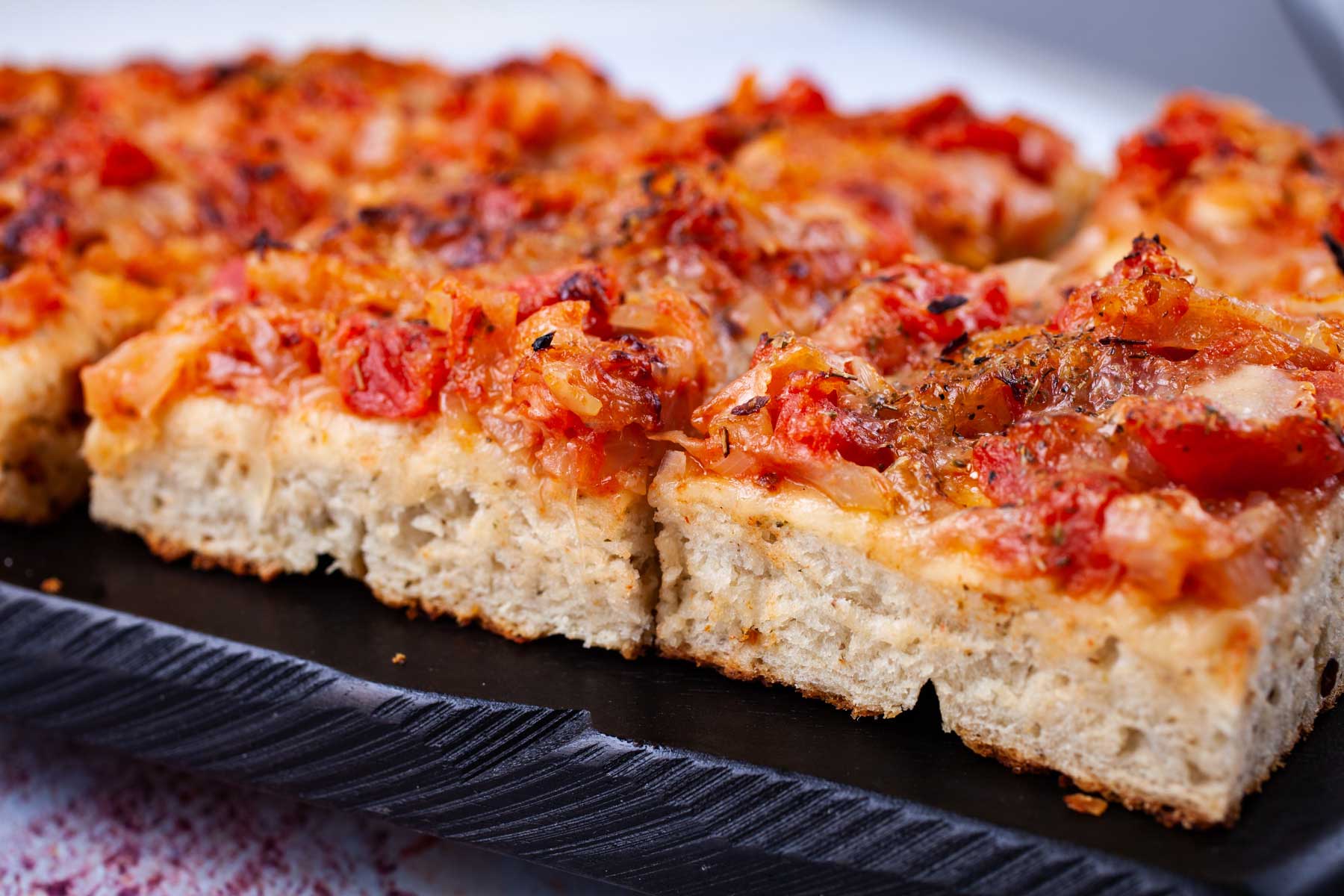
Recipe FAQs
I usually store leftovers in the fridge, stacked in between parchment paper, and sealed in an airtight container. It will last up to five days.
Just reheat in the microwave or pop it back into 350 degrees preheated oven on an olive oil brushed baking sheet (my preference) until hot—time varies depending on the crispiness you want.
Yes, you can. Freeze any leftovers or the whole pizza.
Best to wrap the pizza in waxed paper sheets—you can even use unbleached butcher paper (optional).
Then store it either in an airtight container or freezer bag and then freeze for 1 to 2 months.
Reheat it directly in a 450-preheated oven for about 12 to 15 minutes.
It allows the crust to crisp up, prevents undercooking or sogginess, and becomes quite stable to handle the weight of sauce and toppings.
So here you have it, my homemade version of a Sicilian pizza recipe straight from our Italian cuisine.
Now all that is left to do is for you to try out my family's delicious Sicilian-style thick-crust pizza recipe.
Bon Appetito!
Recommended
Don't forget to subscribe to my Monthly Newsletter!
Have questions? Simply comment below or message me. If you make this recipe, please leave a comment and a starred review below. Thank you!
📖 Recipe

Homemade Thick Crust Sicilian Pizza
Mariska RamondinoEquipment
- 11- x 17-inch rimmed baking sheet About that size
Ingredients
Authentic Sicilian-Style Pizza Dough
- 1 package active dry yeast, rehydrated according to package instructions (see notes) 7 to 9 grams
- ½ teaspoon sugar to feed the yeast
- 3 teaspoons fine salt 17 grams
- 2 tablespoons dried oregano 6 grams
- 2 teaspoons garlic powder 6.5 grams
- 2 teaspoons onion powder 4.6 grams
- 7 ½ cups unbleached bread or all-purpose flour 1 kilo/35.5 ounces plus more to sprinkle the work surface
- 2 ¼ cups water at room temperature, or as required 560 ml
- 4 tablespoons olive oil divided
Pizza sauce & toppings
- 4 tablespoons olive oil divided, plus 1 teaspoon
- 2 large yellow onions thinly sliced about 24 ounces/675 grams
- 1 jar diced or crushed tomatoes 18.3 ounces/520 grams
- 2 ½ teaspoons fine salt
- 1 teaspoon dried oregano
- 1 teaspoon crushed red pepper or more as desired
- ½ cup fine grated Parmesan cheese (optional) 45 grams
Instructions
Make Pizza Dough
- Whisk together salt, dried oregano, garlic powder, onion powder, and flour in a large bowl.3 teaspoons fine salt, 2 tablespoons dried oregano, 2 teaspoons garlic powder, 2 teaspoons onion powder, 7 ½ cups unbleached bread or all-purpose flour
- Then stir in the rehydrated yeast.1 package active dry yeast, rehydrated according to package instructions (see notes), ½ teaspoon sugar to feed the yeast
- Gradually add water. Mix the flour and water by hand until the dough comes together.2 ¼ cups water at room temperature, or as required
- At first, you only get chunks of flour, which is normal. But the flour eventually absorbs all the water, and as you keep kneading, you will form a rough ball (this happens quickly).
- At this point, add one tablespoon of olive oil as you form the dough into a smoother ball. It will give flavor and soften the crust.
- Remove the ball of dough from the bowl and place it on a well-floured flat surface.
- Continue kneading it for about 2 minutes or until the dough becomes smooth and elastic. (During the kneading process, sprinkle the work surface with more flour if the dough feels too sticky, and gently knead it in).
- Place dough in a lightly oiled bowl and cover with a clean kitchen towel. Let it rise for about 90 minutes at room temperature.
- After the initial rising time, take out the baking sheet and coat it with two tablespoons of olive oil (it adds extra flavor to the bottom of the pizza).
- Place the risen dough in the center of the sheet. Gently stretch and push it first into a large oval.
- Then continue to shape it into a rectangular form, evenly covering almost the whole length of the baking sheet, and the dough stops resisting.
- Cover with a clean kitchen towel and let it rise for another 30 minutes at room temperature. If the dough has stretched back a little, gently reshape it into its final form.
- Optional: gently make small dents into the risen dough with the knuckles of your fist to create extra air pockets.
- Note: if you have the time, a 90 minutes second rise instead of 30 will give you an even lighter crust.
- Continue to pre-bake the pizza crust.
Prebake the pizza dough
- During the last 15 minutes of the pizza dough's rising time, preheat the oven to 450°F/230°C.
- Bake the pizza dough on the lowest oven rack for 10 to 12 minutes. It should look mostly pale but firm, with a few light golden brown spots. Remove the crust from the oven.
Make the pizza sauce and toppings
- While the pizza crust is pre-baking in the oven, make the pizza sauce and toppings.
- Cover the bottom of a wide skillet, large enough to hold the onions, liberally with 3 tablespoons olive oil, and heat over medium-high heat.
- Add the onions and cook, frequently stirring, for about 10 to 12 minutes, or until soft and browned.2 large yellow onions thinly sliced
- Stir in the tomatoes—season with salt and ½ teaspoon of dried oregano, and ½ teaspoon of crushed red pepper. Cook and stir for 4 to 5 minutes. Crush the tomatoes with a wooden spoon while stirring.
- Remove the pan from heat. Let it slightly cool and reserve.
Make the Sicilian-style pizza (assemble and bake)
- Distribute the reserved onions and tomatoes on top of the pre-baked pizza crust.
- Sift out any watery liquid—you should have none or very little.
- Top off with ½ teaspoon dried oregano and ½ teaspoon crushed red peppers.
- Brush some olive oil over the corners and sides of the pizza crust.
- Sprinkle the parmesan cheese evenly over the pizza sauce and top it off with 1 teaspoon of olive oil.½ cup fine grated Parmesan cheese (optional)
- Place the pizza back in the oven on the lowest oven rack for another 15 minutes or until the crust is firm at the bottom, crisp at the edges, and the top has bits of charred onions.
- Take it out of the oven and let it sit for a few minutes before serving.
- Cut into squares and serve.
Notes
- Nutrition information is for Authentic Sicilian Dough with Toppings.
- Good quality crushed or diced tomatoes: Best to pick pure sweet tomatoes straight out of the jar or can with no additions (I love the Jovial brand.) They will be seasoned, adding tons of flavor. You can, of course, opt for a pre-made red pasta sauce, but I encourage you to try this version first.
- Let the dough rise properly: For a thick and airy crust, it's important to let it rise properly and at room temperature to develop the gluten strands that give it its structure.
- Always sufficiently oil the pizza pan to achieve that classic Sicilian-style crispy crust.
- Why do I have to pre-bake the pizza crust: it allows the crust to crisp up, especially the bottom, and prevents a sogginess.
- Baking the pizza: Bake this thick pizza close to the oven floor, where the crust will get the most radiant heat from the base. It will help crisp up the bottom and create a beautiful crunchy golden-brown pizza crust.
- Let the pizza sauce slightly cool before topping it on your thick-crust pizza dough.
- Other toppings: Traditionally, it is a meatless sauce made from tomatoes, lots of onions, and herbs sans the anchovies. If you are going for the New York Style Sicilian pizza, sprinkle on top mozzarella (if you don't mind some dairy) during the last 15 minutes of baking time or, as suggested, grated Parmesan cheese.
- How to rehydrate active dry yeast: see step-by-step instructions with pictures in this post or use the same process as this Fig Cake. Here are the instructions:
- Use 7 to 9 grams of active dry yeast and place the content of the package in a small bowl.
- Add a bit of sugar—about ½ teaspoon. It feeds the yeast and helps you determine if it is still active. A pinch of sugar will make the yeast bubble, proving it hasn't expired.
- Stir in ¼ cup lukewarm water! You need warm water between about 110°F-115°F. It will stay inactive if too cold, and the yeast will die if too hot.
- You can use an instant-read thermometer. I usually test the warmth of the water with my wrist. It should feel very warm but not hot.
- Then let it rest for about 5 to 10 minutes (best to cover it with a clean kitchen towel). If active, the yeast should dissolve in the water and bubble. If not, the yeast is dead, or your water is too hot or cold.
Add your own private notes
Whenever you come back to this recipe, you’ll be able to see your notes.
Nutrition (% Daily value)
Disclaimer: This nutritional data is calculated using third party tools and is only intended as a reference.




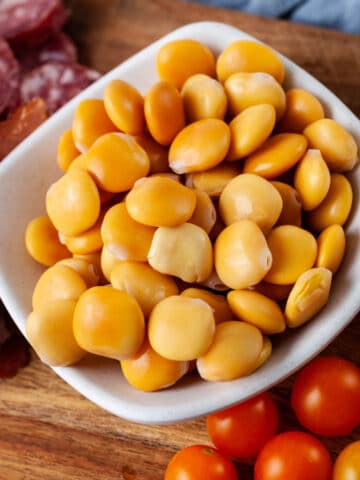

Brendan Talbert says
I do have access to fresh yeast. What is the measurement for fresh?
Mariska Ramondino says
Hi Brendan. Thank you for stopping by. It has been a while, but I believe you should use 2.5 to 3 times the amount of active dry yeast. So, if the recipe calls for 7 grams active dry yeast, use anywhere from 17.5 to 21 grams fresh yeast. Make sure your fresh yeast smells pleasant and crumbles easily and always proof it first before adding it to the flour. It's always best to test if your yeast is still active before doing all the work and you'll get a better rise too. Good luck and let me know how it goes.